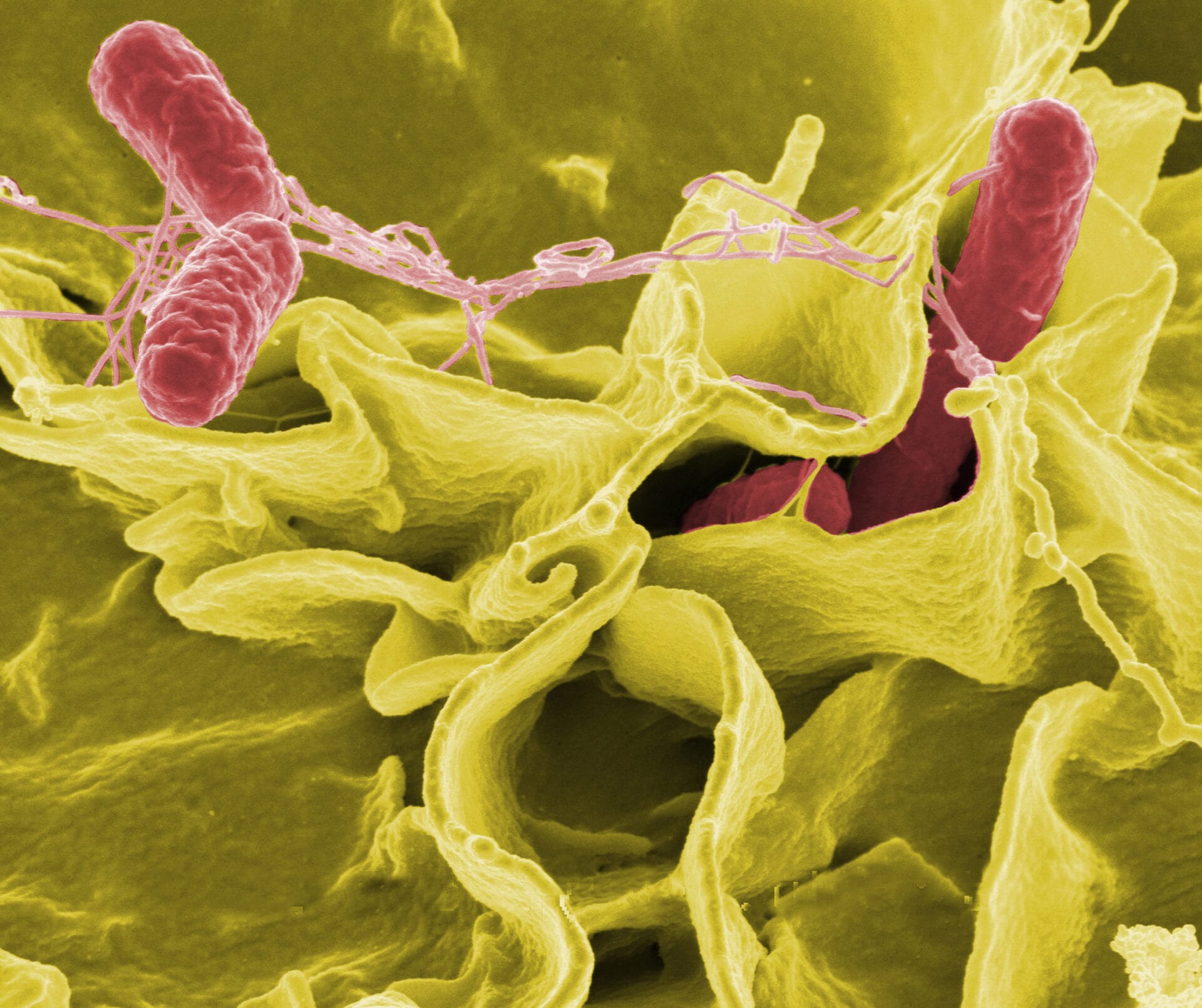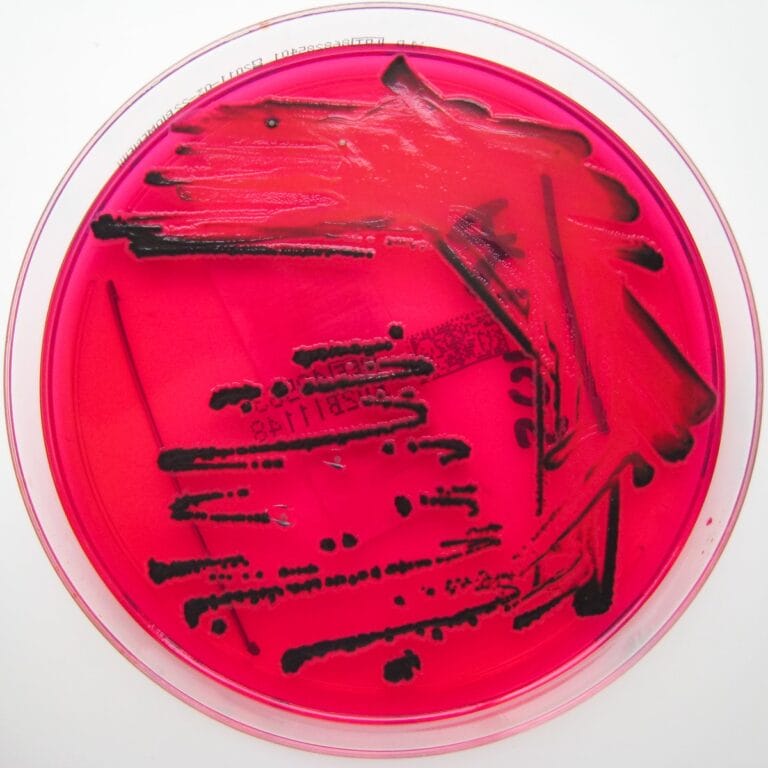What is Salmonella?
Image credit: Rocky Mountain Laboratories,NIAID,NIH
Color-enhanced scanning electron micrograph showing Salmonella typhimurium (red) invading cultured human cells.

Salmonella is a group of bacteria that cause a wide spectrum of diseases in humans and animals
- The bacterial group Salmonella causes infections and illnesses in both humans and animals.
- Most cases of Salmonella infection are mild, but sometimes they can be life-threatening.
- Salmonella is one of the microbes that have started to develop antimicrobial resistance, which is a major public health concern.
What is Salmonella?
- Salmonella is a group of bacteria that can be divided into two species: Salmonella enterica and Salmonella bongori.
- The species we hear most about is Salmonella enterica, which is estimated by the World Health Organization (WHO) to affect over 17 million people worldwide each year.
- The two species can be divided into more than 2,500 subtypes. Two subtypes of Salmonella enterica are S e Typhimurium and S e Typhi.
- S e Typhimurium and S e Typhi are closely related. However, there are distinct differences in the type and severity of infectious disease they both cause.

Different subtypes of Salmonella enterica
Salmonella enterica Typhimurium
- Salmonella enterica Typhimurium can cause infections in humans and animals. It can be transferred to humans through raw or undercooked infected food including meat and eggs.
- In poultry, Salmonella enterica Typhimurium is passed from bird to bird, most commonly through their droppings.
- When infected poultry are slaughtered, the Salmonella bacteria can be transferred from their gut to the meat and can also be passed from the bird’s ovaries to their eggs.
- Salmonella Typhimurium causes gastroenteritis (inflammation of the gut) which can lead to diarrhoea, vomiting, fever and abdominal cramps. These symptoms may last up to seven days.
- People infected by Salmonella Typhimurium rarely require antibiotics or hospitalisation.
- However, antibiotics or other treatments may be needed if an individual is unable to fight off the infection themselves due to an underlying condition, such as a compromised immune system.
Salmonella enterica Typhi
- Salmonella enterica Typhi can only infect humans. It is common in countries where hygiene is poor, and the water can be contaminated with sewage.
- It causes typhoid fever, with symptoms such as fever, weakness, stomach pains, headache or loss of appetite.
- Without prompt treatment, Salmonella enterica Typhi infection can lead to liver damage, inflammation of the heart, holes in the gut, and internal bleeding.
- If appropriate treatment is not given, typhoid fever is fatal in up to 20% of affected individuals.
- People with typhoid fever carry the Salmonella Typhi bacteria in their blood and intestines and shed the bacteria in their poo. Typhoid is diagnosed by way of a blood or stool sample.
- For individuals travelling to a country where typhoid is common, a vaccination against Salmonella enterica Typhi is recommended.
Studying the genetics of Salmonella
- Scientists at the Wellcome Sanger Institute in Cambridge, UK, have sequenced the Salmonella genome to examine the genes found in different strains of Salmonella.
- By comparing the genes of different strains, scientists can understand how they cause disease and could be treated. It can also show how the bacterium’s genome has changed over time to enable it to be resistant to common antibiotics.
- For example, scientists have shown that all strains of Salmonella have a single chromosome with a set of core genes that have functions related to survival.
- However, S. e. Typhimurium has 479 unique genes and S. e. Typhi has 609 unique genes. Each of the different species and subtypes have blocks of genes that are unique to them and control how effective they are at infecting individuals or avoiding antibiotics.
- Some Salmonella species might carry extra DNA separate to their single chromosome which can also carry genes that help drive antibiotic resistance.
Antibiotic resistance in Salmonella
- The frequent use of a limited range of antibiotics has led to strains of Salmonella that are resistant to antibiotics.
- This is making it harder to treat severe Salmonella infections, as the antibiotics are less effective.
- Scientists believe that Salmonella enterica Typhi, the subtype that frequently needs treating with antibiotics, has been evolving resistance since at least the 1970s.
- Genome sequencing at the Sanger Institute has revealed this is due to the acquisition of genes that help with antibiotic resistance.
- The evolution of antibiotic resistance in Salmonella would have started with penicillin, which created a selective pressure on bacteria. Over time, the bacteria evolved to become resistant to other antibiotic drugs, including amoxicillin and chloramphenicol, which were widely used in the 1990s.
- In addition to gaining genes involved in antibiotic resistance, some Salmonella subspecies have lost the function of some genes which helped them to infect other animals beyond humans.
- This suggests that they are adapting specifically to survive within human hosts.